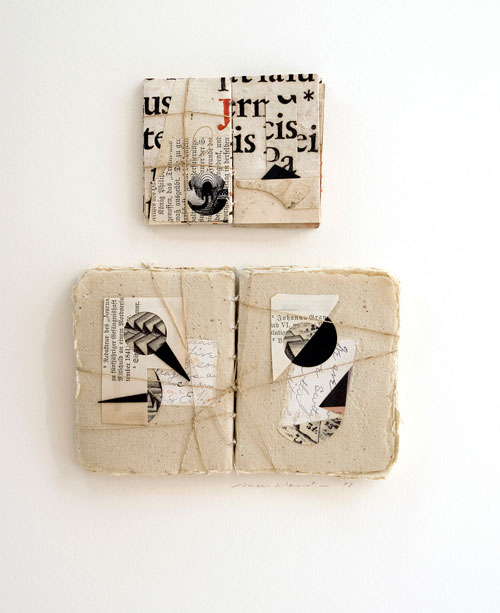Have you ever admired a particularly finely bound book? Perhaps you noticed the quality of paper, letterpressed text, or a foil-stamped embossment on a deluxe edition. Though the book is primarily discussed as a vehicle for ideas, it is still a three-dimensional object with material qualities to consider. The artist’s book as a contemporary art form experiments with the physical form of the book to accomplish the same goal as a more traditional book: to communicate ideas.

Body of Inquiry by Casey Gardner. 2011. Triptych with interior codex. Image copyright Abecedarian Gallery.
Artists’ books come from a tradition of illuminated manuscripts, livres d’artistes, fine press books, ephemera, and early twentieth-century artistic experimentations with the book. A contemporary investigation would be hard-pressed to find a singular definition for artists’ books, but we could generalize that they are a category of artworks which use the forms or ideas of the material book as a preliminary structure. Since artists’ books are subject to a variety of whims and artistic media, they can take on a multitude of formats.

Tree Structures by Elizabeth Holster. 2011. Accordion with handmade paper/collage. Image copyright Abecedarian Gallery.
Artists’ books can employ a broad range of structures and bindings, from long-stitched to perfect-bound to accordions. The entire historical and contemporary materiality of books is part of the subject matter and influences an artist’s choice in materials. Artistic commentary can be made through these material choices; however, there is often a focused concept for an artist’s book. Binding, engineering, enclosures, paper, typography, and printing techniques are all technical elements to be specifically considered in relation to the concept in the creation of an artist’s book.

Pathways by Macy Chadwick. 2010. Machine-stitched Kimodesk film. Image copyright Abecedarian Gallery.
Recently, we posted about some experimental printed books that fit outside of the box of regular paperbacks: books that are meticulously die-cut and 3D printed. To clarify the production differences between artists’ books and our familiar paperback, it would be best to place them on a spectrum. At one end is the commercially printed book: the kind of book Ooligan Press creates and sells. Hundreds or thousands of copies can be printed, trimmed, and sold, simply by delivering digital files. The books considered in our previous post fall in the middle of the spectrum. These have artistic and meticulous printing requirements, but are still produced by high-tech methodologies. At the other end of this material book spectrum lie artists’ books. These are much smaller editions, often printed in runs of less than one hundred, since they are produced from start to finish by hand. Of course, this variability is at the discretion of the needs and skills of the artist, but I believe it is safe to say that these small edition sizes make them a rarer commodity than a mass-produced book.

Book Bundles a&b by Margaret Suchland. 2007. Miniature book coptic-bound with handmade paper and eighteenth-century ephemera. Image copyright Abecedarian Gallery.
There are many ways to explore historical and contemporary artists’ books, and an institutional collection is often an extremely good place to start. In Portland, a point of interest is the Special Collection at Reed College. Other resources include community centers which have workshops, outreach, and exhibitions, like the San Francisco Center for the Book and Atelier 6000. Community galleries and print shops are also places to meet artists working in the medium, like Em Space and the IPRC in Portland.
While artists’ books will not become part of the Ooligan catalog in any foreseeable future, there are ways in which artists’ books and Ooligan might collide. First, an appreciation of and investigation into experimental forms of the book can provide new ways of approaching book design. Second, there is a large community of shops, artists, and small publishers working in this medium both in Portland and beyond, and we are excited to announce that Ooligan intends to be another small part of the this print community. We are in the process of getting our own Chandler & Price platen press back up and running as a resource for Ooligan Press and the book publishing program. Expect newly letterpressed things from Oolies in the near future!

